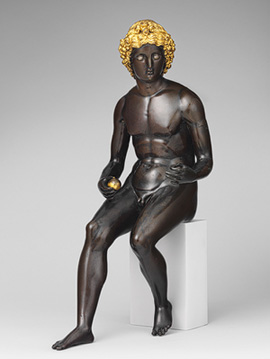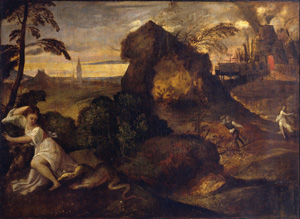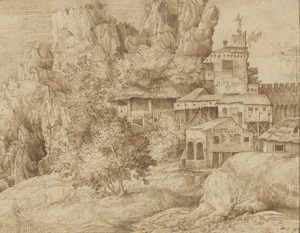Beyond Venice
John Haberin New York City
Antico and Renaissance Bronzes
North Italian Paintings from Bergamo
Renaissance Venice: Drawings from the Morgan
If people remember much of anything about art, it might be that the Renaissance rediscovered antiquity. Not every art movement gets to name itself, and most legends about them are largely false, but this one had a point. "Truly," wrote its first great theorist, in Latin at that, "if this were ever written by others, we have dug this art up from under the earth. If it was never written, we have drawn it from heaven."
And if one can point to a single discovery as a part of that history, it came in a future pope's vineyard.  On the eve of the High Renaissance, in 1489, Romans unearthed the Apollo Belvedere from the second century AD. A god steps forward, in a marble copy of a Greek original, to aim his arrow and to release its shaft. Within a year, an artist from Mantua has matched it in bronze—with a claim to antiquity in his very signature on its base, Antico. How, then, did Antico vanish into obscurity even before his death, in 1528? In part, he marked a mere aside in history, with polite sculpture to match. Yet he had a real knack for reinventing antiquity, and he says a great deal about what history leaves out.
On the eve of the High Renaissance, in 1489, Romans unearthed the Apollo Belvedere from the second century AD. A god steps forward, in a marble copy of a Greek original, to aim his arrow and to release its shaft. Within a year, an artist from Mantua has matched it in bronze—with a claim to antiquity in his very signature on its base, Antico. How, then, did Antico vanish into obscurity even before his death, in 1528? In part, he marked a mere aside in history, with polite sculpture to match. Yet he had a real knack for reinventing antiquity, and he says a great deal about what history leaves out.
I had planned a trip to Italy obsessively, from days in Venice and its churches to side trips for breathtaking fresco cycles. That left just an afternoon in Florence, with one goal—the birth of Renaissance painting in all its humanity and tragedy. Of course, the trips took a few hours longer than expected, given Italy's trains, and both the churches that I sought that last day had shut their doors, for restoration. There was nothing to do but surrender to chance, and this being Florence, I found myself in minutes alone with a Botticelli. Step off the beaten path, it seemed to say, and make your own discoveries. Now the Met proposes exactly that, with fifteen Italian paintings from the Accademia Carrara, Bergamo, while drawings from the Morgan bring one back to Renaissance Venice.
Digging up antiquity
"Antico: The Golden Age of Renaissance Bronzes" assembles thirty-nine sculptures, for some three-quarters of his work. The Frick shows a skilled restorer, able to fill in missing limbs or a missing arrow, like Apollo's. It shows a quest to emulate Rome closely, as a model for both art and empire, but also a willingness to tinker with the past in search of refinement. Apollo gets a smaller scale, a left foot more delicately balanced on its toe, gilded hair, elaborate curls, and a touch of silver. Thanks to a technique called indirect casting, Antico can also turn out multiples. And he can "improve" things again twelve years later—with a more restrained hairdo, a less upturned gaze, slightly firmer muscles, and that foot raised a bit higher.
The curators, too, are willing to rewrite history, going back to how the Renaissance itself did. Eleonora Luciana of Washington's National Gallery, the Frick's Denise Allen, and Claudia Kryza-Gersch of the Kunsthistorisches in Vienna are asking about the place not just of an artist, but of the decorative arts as well. No one will mistake Antico for Michelangelo wrestling with classicism, his emotions, his sexuality, his solitude, and marble itself. Skill and beauty alone shine, even if a little skill and beauty go a long way. They also have a purpose—elevating a patron's claims to empire and refinement. In giving Alexander the Great a Persian cloak and a ribbon diadem, in recreating Marcus Aurelius on horseback as philosopher and warrior, or in creating a languid Cleopatra out of whole cloth, Antico was giving the rulers of Mantua the ancestors they wished.
With the Renaissance portrait and "Hidden Portraits," the Met showed artists moving among warring principalities and petty dictators. Like Pisanello, Antico, too, worked in relief medals and in profile—in one case on the back of an actual ancient coin. Pier Jacopo Alari de Bonacolsi acquires his nickname in a letter of 1847, at thirty-two, on or around his first visit to Rome. By 1500 he relocates to the Mantuan castle, as court sculpture, but by then he may well have completed his last relief, with the labors of Hercules. Here he perfects a hero's quarter turn and gilded cloak thrown to the winds. From then on, the sculptor focuses on statelier motion in three dimensions.
He consistently signals motion and restraint as he restores the classics, much like Bertoldo di Giovanni in Florence. Almost everyone gets the forceful curve called contrapposto and punched eyes in place of the antique blank stare, and almost everyone gets bustier—but even Venus gains in modesty. Gesture counts more than violent action, like Apollo's raised toes—or the emperor's horse, with gently raised feet. Where the Roman original for Mercury had lost its arm, Antico gives him a pointed index finger. The combination of decorative refinement and action anticipates Rome after Raphael, but without Mannerism's wilder emotions. It also helps explain how the artist so quickly dropped out of history.
Mantua was itself a Renaissance aside between moments of eruption. Mantegna had passed through, with his own frescoes devoted to the nobility. And the curators look for hints of Mantegna's Dead Christ in an Entombment. Yet Antico sticks to relief profiles in place of the Venetian's virtuoso perspective. The first great Renaissance theorist passed through as well, with his most mature work. Leon Battista Alberti designed the city's greatest church in 1470, although he did not live to see it.
Successive casts may mean no more than workshop variation. Still, they point to the vagaries of history. In that quote, Alberti values not a copy, but a new art drawn from heaven—for the ancients, he says, had it too easy with their models. "Our fame ought to be much greater, then, if we discover unheard of and never before seen arts and sciences without teachers or without any model whatsoever," as Florence had boasted with Lorenzo Ghiberti's Gates of Paradise. The next year, Alberti translated his treatise on painting into his native language, as Della Pittura. As with late Renaissance sculpture in the north, the place of flattery and decoration was about to change as well.
Off the beaten path
Bergamo, halfway from Milan to Venice, fell just within the latter's inland sphere of influence. Lorenzo Lotto settled in for a while, to help wrap up the High Renaissance with his visions. Naturally the curators, Andrea Bayer of the Met and M. Cristina Rosechini of Bergamo, present loans from it as a brief history of Northern Italian painting. And naturally they title the show after its stars, "Bellini, Titian, and Lotto." Naturally, too, the attribution to Titian is uncertain, the Giovanni Bellini early and harsh, and a trio by Lotto merely predella panels—smaller paintings that serve as a visual footnote to an altarpiece, in this case with a fourth panel missing. A portrait by Lotto grants its pudgy sitter a glorious crescent moon and a fur wrap, the marten's head intact. She raises one hand to her breast to show off her jewelry, although also as a dispenser of maternal warmth.
 For the rest, most visitors will never have heard of them. The museum, its neoclassical building itself closed for restoration, had its origins in private collections in the eighteenth and nineteenth centuries. That explains minor painters and old-world tastes. Maybe the beaten path pays off after all. The Renaissance is a long time ago, and a little homework can help bridge the centuries. Still, that leaves room for discovery and close encounters with history.
For the rest, most visitors will never have heard of them. The museum, its neoclassical building itself closed for restoration, had its origins in private collections in the eighteenth and nineteenth centuries. That explains minor painters and old-world tastes. Maybe the beaten path pays off after all. The Renaissance is a long time ago, and a little homework can help bridge the centuries. Still, that leaves room for discovery and close encounters with history.
Bellini before 1460 is still working in tempera rather than oil, influenced by Mantegna's hard edges. They make grief all the more real, with Mary and John short of tears, as if unable to find release—and Jesus so human that he seems less dead than asleep in their arms. Titian around 1510 still builds on Giorgione's dreamy landscapes, as a setting for scenes from myth. Orpheus and Eurydice seem to be leaving an Italian city rather than the dead, with a cave ahead like another mouth of hell and a distant tower like an earthly heaven. Lotto picks up on Mantegna, too, with a virtuoso dead man on his back, his head toward the viewer. Other characters divide into groups with their own stories, including monks posed rather like a 1950s a cappella quartet.
Early Renaissance painting surely does begin in Tuscany, with Gentile da Fabriano and Masaccio a generation before Botticelli. Here, too, the emergence of a truly northern style takes time. Vincenzo Foppa in Milan looks to Florence's models in sculpture, architecture, and classicism. His Three Crosses echo classical columns in the foreground, with relief heads as on antique coins, and the arch above frames a distant and more than slightly mad city. A Nursing Madonna belongs to Bergognone, sometimes called the Lombard Fra Angelico. Mary has the nose of a portrait, and the proverbial closed garden of her virginity looks like a familiar and welcoming village.
Bergognone also paints a convincing street scene, separated from his saints by a low curtain, like the entrance to a private club. Next comes a step past their theatrical gestures toward the High Renaissance. A painting from Bellini's workshop puts a Madonna at the top of a grand triangle in composition and circle in depth. Jesus and a saint gesture convincingly, the embroidered curtain behind them flaps upward, and the donor faces front with an unapologetic frown. Early Titian influences a stiff but frank portrait backed by a shimmering blue mountain. In a painting from 1505, Saint Jerome turns his back on a cross, his own Bible, and the very idea of a vision, with a bridge leading to an ordinary church and red sky.
Mannerism in Venice lacks the emotional excess of the 1500s in Florence. Moretto da Brescia comes closest in contrasting a dark sky with electric highlights, a circle round the moon, and a man whose book has fallen to the ground at the sight of Jesus walking on earth. By the 1560s, Giovanni Battista Moroni has settled into portraiture and professionalism. He flatters a young man's intelligence and aristocratic reserve, while permitting a child to grasp her pearls. I might still not leave the beaten path for Bergamo. Now I know, though, that it was a part of history.
Pastoral, portrait, and proficiency
After Bergamo, you may feel that you know northern Italy a bit better. Then again, you may want to see how it is really done. As it happens, the Morgan Library has its own view of "Renaissance Venice," with drawings from the collection—and you know what? They make it look easy. Surely Titian does late in life, as a saint slays a dragon while barely moving a finger, and the creature might have come not from myth, but from a dog lying on the road. Titian's pen makes it look easy, too, setting water motion and houses casually against a hill.
Or maybe you want to know literally how it is done. Vittore Carpaccio teaches how to build a figure with black chalk, white chalk, and a brown wash. He also wields a heavily loaded pen to group hermits in a decidedly nonhermetic landscape. Lorenzo Lotto uses draperies to animate a saint without breaking his stillness faced with a revelation—and a grid, for transfer to canvas, shows how a painting is made as well. Later still, Paolo Veronese draws in ink as if thinking aloud, so that a torso becomes an oval and an eye a dotted circle. Palma Giovane's tribute, to an artist who died young, holds a sketch pad as if he were texting.
Not that artists always have it easy. Titian and Veronese leave letters flattering a patron and arranging the shipment of an altarpiece. Nor is everyone famous. Antonello da Messina, an early exponent of oil painting, leaves his mark only in an anonymous follower's female portrait. Giovanni Bellini and his workshop looms as large as ever. You probably did not know of Giulio Campagnola's role in making landscape independent of narrative, but his tiered buildings supply a missing link from Giorgione to northern Europe. 
A rival of Titian, in the 1530s, pushes High Renaissance control into Mannerism. il Pordenone crowds a stately procession, like an undisciplined profile relief sculpture. Where a Conversion of Saint Paul usually clears room for Paul struck down at the foot of his horse, Pordenone's horses charge in all directions. As for Mannerist excess made easy, Tintoretto uses little more than thick parallels in charcoal to model an emperor's fleshy face tilted upward—aspiring at once to gluttony, power, and heaven. Actually the city of God, or rather Augustine's City of God, makes its appearance, too, in 1475, only six years after movable type reached Venice. The same artist (possibly Girolamo da Cremona) illustrates a volume of Aristotle, with philosophers disputing on a balcony while a child, deer, and rabbits bring metaphysical speculation back to earth.
The show's organization by landscape (or pastoral), patronage, portraiture, and printing says more about alliteration than genre. It also notes the role of courtly music. Paris Bordone, in the 1530s, integrates musicians into a landscape and with their instruments. Having printing on a par with drawing also stresses the intellectual underpinnings of the Renaissance. Books on architecture by Vitruvius and Palladio (who also had the Vitruvius printed) insist on painting, too, as a liberal art concerned with space. They also place an ancient theorist alongside a "modern" one—and a text-heavy volume alongside one with diagrams.
To confuse things further, sections for "innovation" in drawing and for Venice's inland possessions double back to some of the same artists—as with Pordenone's frenzied Crucifixion for Cremona cathedral in 1520. That way, you may actually think for a moment about Bergamo. Then it uses the Venetian empire as an excuse to catch other artists passing through. El Greco stops by, although he may or may not have drawn a moving Pietà, its figures seemingly weighed down by their own dark shadow. Albrecht Dürer sketches the patron for a German church at the heart of Venice, the Rialto. A brief, meandering history of western drawing ends where it should, on the beaten path.

"Antico: The Golden Age of Renaissance Bronzes" ran at The Frick Collection through July 29, 2012, "Bellini, Titian, and Lotto: North Italian Paintings from the Accademia Carrara, Bergamo" at The Metropolitan Museum of Art through September 3, and "Renaissance Venice: Drawings from the Morgan" at The Morgan Library through September 23.




